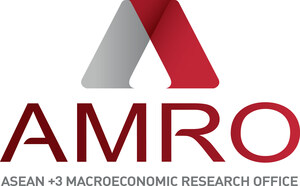SINGAPORE, Oct. 4, 2023 /PRNewswire/ -- The ASEAN+3 Macroeconomic Research Office (AMRO) maintained its 2024 growth forecast for the ASEAN+3 region in its October quarterly update of the 2023 ASEAN+3 Regional Economic Outlook (AREO). Despite the less sanguine outlook for the global economy next year, growth in the region will be supported by the expected turnaround in manufacturing exports and improving growth momentum in China.
The ASEAN+3 region is forecast to grow by 4.3 percent this year, down from July's projection of 4.6 percent, due mainly to the weaker-than-expected growth in China in the second quarter. AMRO expects the region to expand by 4.5 percent in 2024, as the impact of China's policy support measures to boost domestic demand materializes more fully. This, along with the gradual pick-up in durable goods consumption in the United States and the anticipated recovery of the global technology cycle, should boost regional exports next year amid expected weakness in the global economy.
"Despite the gloomy headlines surrounding China's economic performance, we must view things in perspective," said AMRO Chief Economist, Hoe Ee Khor. "Beyond the real estate sector, manufacturing investment is holding up and consumer spending is starting to get back on track—these should have positive spillover effects across the rest of ASEAN+3."
Inflation in the ASEAN+3 region—excluding Lao PDR and Myanmar—is forecast to moderate to 2.6 percent in 2024, from this year's estimate of 2.9 percent. However, the resurgence of global food and energy prices in recent months is sparking concerns of another commodity price spike, with the risk of higher inflation becoming more salient.
"El Niño is the wild card for inflation, especially if it leads to additional restrictive trade policies on key agricultural imports such as rice," Khor cautioned. "The impact of commodity prices on ASEAN+3 inflation will be sharper, if the strength of the US dollar relative to the region's currencies continues."
AMRO also warns against fully discounting the risk of recession in the United States and euro area, especially in an environment where global interest rates could stay higher for longer. Should recession in both economies materialize, growth in the ASEAN+3 region could slide below 3 percent—the lowest since 1998 barring the pandemic-induced slowdown of 2020.
AMRO's conclusions are found in the latest quarterly update of its flagship report, the ASEAN+3 Regional Economic Outlook (AREO). The next update will be published in January 2024.
About AMRO
The ASEAN+3 Macroeconomic Research Office (AMRO) is an international organization established to contribute toward securing macroeconomic and financial resilience and stability of the ASEAN+3 region, comprising 10 members of the Association of Southeast Asian Nations (ASEAN) and China; Hong Kong, China; Japan; and Korea. AMRO's mandate is to conduct macroeconomic surveillance, support regional financial arrangements, and provide technical assistance to the members. In addition, AMRO also serves as a regional knowledge hub and provides support to ASEAN+3 financial cooperation.
SOURCE ASEAN+3 Macroeconomic Research Office (AMRO)

WANT YOUR COMPANY'S NEWS FEATURED ON PRNEWSWIRE.COM?
Newsrooms &
Influencers
Digital Media
Outlets
Journalists
Opted In


Share this article